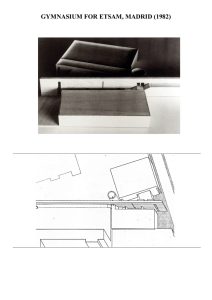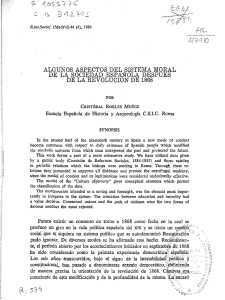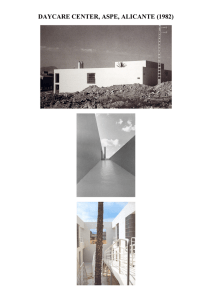Folleto Vive la Historia. Parador de Santo Estevo
Anuncio
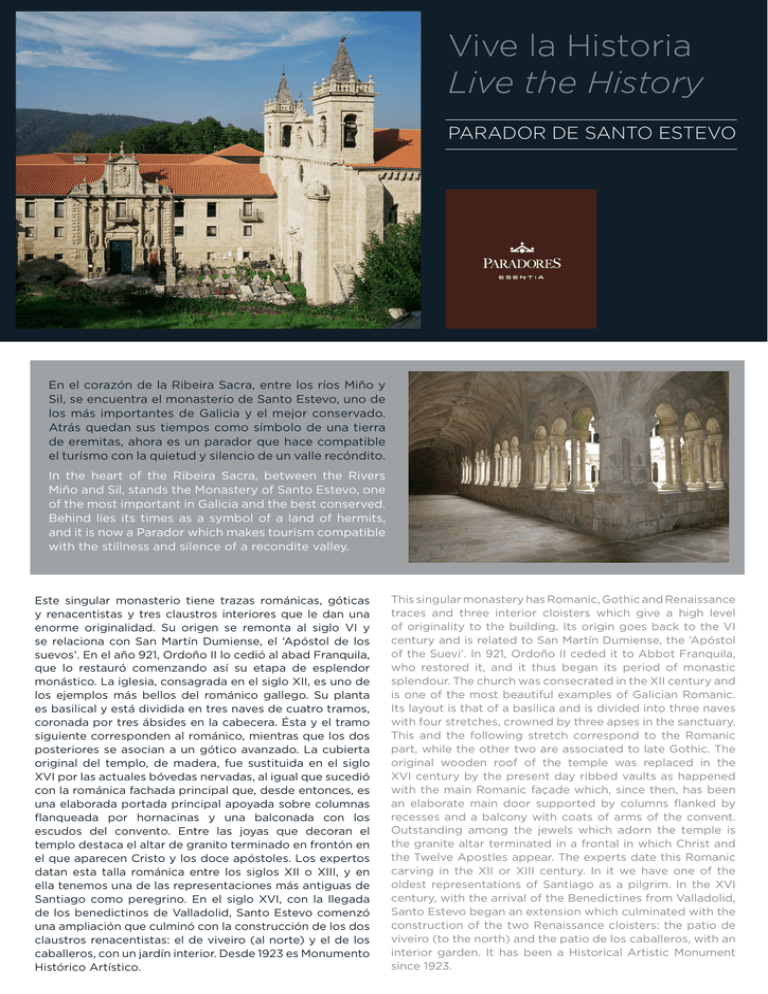
Vive la Historia Live the History PARADOR DE SANTO ESTEVO En el corazón de la Ribeira Sacra, entre los ríos Miño y Sil, se encuentra el monasterio de Santo Estevo, uno de los más importantes de Galicia y el mejor conservado. Atrás quedan sus tiempos como símbolo de una tierra de eremitas, ahora es un parador que hace compatible el turismo con la quietud y silencio de un valle recóndito. In the heart of the Ribeira Sacra, between the Rivers Miño and Sil, stands the Monastery of Santo Estevo, one of the most important in Galicia and the best conserved. Behind lies its times as a symbol of a land of hermits, and it is now a Parador which makes tourism compatible with the stillness and silence of a recondite valley. Este singular monasterio tiene trazas románicas, góticas y renacentistas y tres claustros interiores que le dan una enorme originalidad. Su origen se remonta al siglo VI y se relaciona con San Martín Dumiense, el ‘Apóstol de los suevos’. En el año 921, Ordoño II lo cedió al abad Franquila, que lo restauró comenzando así su etapa de esplendor monástico. La iglesia, consagrada en el siglo XII, es uno de los ejemplos más bellos del románico gallego. Su planta es basilical y está dividida en tres naves de cuatro tramos, coronada por tres ábsides en la cabecera. Ésta y el tramo siguiente corresponden al románico, mientras que los dos posteriores se asocian a un gótico avanzado. La cubierta original del templo, de madera, fue sustituida en el siglo XVI por las actuales bóvedas nervadas, al igual que sucedió con la románica fachada principal que, desde entonces, es una elaborada portada principal apoyada sobre columnas flanqueada por hornacinas y una balconada con los escudos del convento. Entre las joyas que decoran el templo destaca el altar de granito terminado en frontón en el que aparecen Cristo y los doce apóstoles. Los expertos datan esta talla románica entre los siglos XII o XIII, y en ella tenemos una de las representaciones más antiguas de Santiago como peregrino. En el siglo XVI, con la llegada de los benedictinos de Valladolid, Santo Estevo comenzó una ampliación que culminó con la construcción de los dos claustros renacentistas: el de viveiro (al norte) y el de los caballeros, con un jardín interior. Desde 1923 es Monumento Histórico Artístico. This singular monastery has Romanic, Gothic and Renaissance traces and three interior cloisters which give a high level of originality to the building. Its origin goes back to the VI century and is related to San Martín Dumiense, the ‘Apóstol of the Suevi’. In 921, Ordoño II ceded it to Abbot Franquila, who restored it, and it thus began its period of monastic splendour. The church was consecrated in the XII century and is one of the most beautiful examples of Galician Romanic. Its layout is that of a basilica and is divided into three naves with four stretches, crowned by three apses in the sanctuary. This and the following stretch correspond to the Romanic part, while the other two are associated to late Gothic. The original wooden roof of the temple was replaced in the XVI century by the present day ribbed vaults as happened with the main Romanic façade which, since then, has been an elaborate main door supported by columns flanked by recesses and a balcony with coats of arms of the convent. Outstanding among the jewels which adorn the temple is the granite altar terminated in a frontal in which Christ and the Twelve Apostles appear. The experts date this Romanic carving in the XII or XIII century. In it we have one of the oldest representations of Santiago as a pilgrim. In the XVI century, with the arrival of the Benedictines from Valladolid, Santo Estevo began an extension which culminated with the construction of the two Renaissance cloisters: the patio de viveiro (to the north) and the patio de los caballeros, with an interior garden. It has been a Historical Artistic Monument since 1923. LOS NUEVE ANILLOS DE LOS OBISPOS La llegada de nueve obispos en los siglos X y XI huyendo de la invasión musulmana hizo de Santo Estevo lugar de peregrinación. Hasta aquí acudían los fieles en busca de un milagro y se lo pedían a los obispos yacentes ante el cofre de plata que contenía sus nueve anillos. En su honor fue construido en el siglo XIII el “Claustro dos Bispos”, el más antiguo del cenobio. THE NINE RINGS OF THE BISHOPS The arrival of nine Bishops in the X and XI centuries, fleeing from the Muslim invasion, made Santo Estevo a place of pilgrimage. The faithful came there in search of miracles and prayed to the recumbent Bishops for these before the coffer which contained their nine rings. In the XIII century, the “Claustro dos Bispos” was built in their honour, and is the oldest in the monastery. LA IDOLATRÍA DE SALOMÓN POR LUCA GIORDANO Dentro del parador destaca este cuadro del siglo XVII, parte de una serie que realizó el autor sobre la vida de Salomón. En él, el rey judío está frente a un altar rodeado de las mujeres de su harén, las que, según las Escrituras, le introdujeron en los mitos paganos ajenos a Israel. En realidad, simboliza el alejamiento de la ley de Yahvé y el abandono de su rectitud y sabiduría al final de su vida. THE IDOLATRY OF SOLOMON BY LUCA GIORDANO This painting of the XVII century is outstanding in the Parador. It is part of a series painted by the artist on the life of Solomon. In this one, the Jewish King is before an altar surrounded by the women of his harem, who, according to the Scriptures, introduced him to the pagan myths alien to Israel. In fact, it symbolises the distancing from the Law of Yahveh and the abandonment of his rectitude and wisdom at the end of his life. TAMBIÉN LE GUSTARÁ: YOU WILL ALSO LIKE THE FOLLOWING: Ruta del Románico. The Romanic Route Ruta de los Framontanos. The Route of the Foramontanos Ruta fluvial por el Sil. The waterway route by the River Sil Categoría: Convento Fecha: 2004 Arquitecto: Alfredro Freixedo Alemparte BIC: Monumento Category: Convent Date: 2004 Architect: Alfredro Freixedo Alemparte BIC (Property of Cultural Interest): Monument
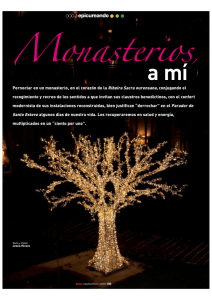
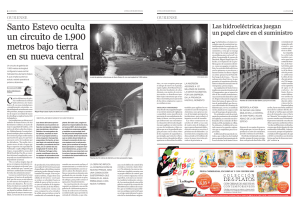
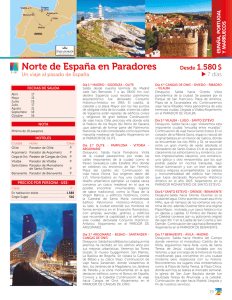

![Santo Estevo y su Parador [folleto]](http://s2.studylib.es/store/data/007736539_1-d72d3dcd3ed1b44ff4a3c8871689d914-300x300.png)


